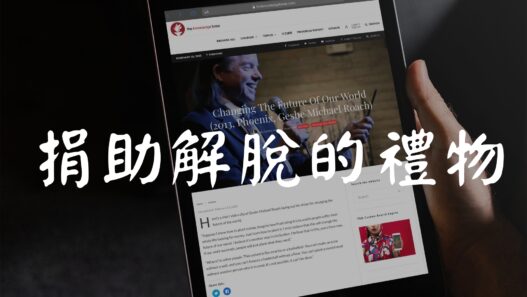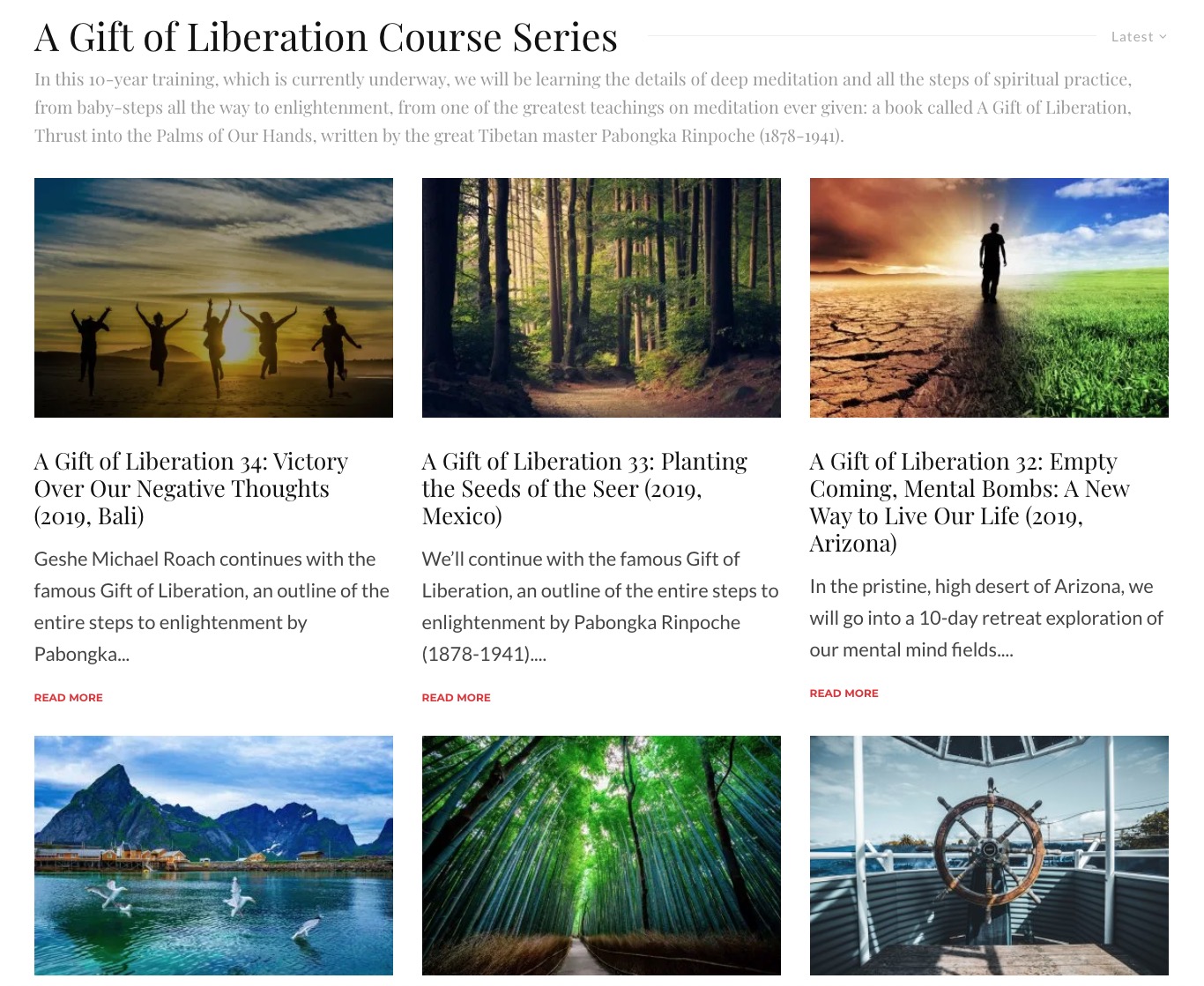掌中解脱 第40期: 空性冥想的魔力 – 施与受自他交换
我们达到了我们传统中最珍贵的两种冥想练习,
旨在帮助我们培养慈悲和爱的深刻体验:自他交换,以及施与受冥想
这两种广为人知的冥想是粉碎我们自我珍爱和自私的关键;这两者都是被我们最糟糕的习性所铐住:相信事物就是它们自己本身。
在这个为期 10 天的钻石山冥想静修营中我们将探索每一种冥想的细微差别,并提出以下问题:
如果我们真正理解我们的世界,甚至包括我们的冥想练习,都是我们过去如何对待他人的结果……我们如何利用对空虚的这种关键理解来推动我们世界中期望的转变?
这些冥想练习实际上如何为改变提供燃料和种子?
来自TKB的消息:
这个项目还在持续进行中,仍在编辑所有的中文音频和视频。
总共有8 种语言,超过 240 个音频和视频文件需要编辑,因此需要花些时间。
当我完成每一堂课时,会上传到在这里和 Youtube 上,所以请持续查看更新内容。
视频
是一个视频播放列表,从最近发布的课程开始。只需点击观看下一个视频,即可观看本系列的其他视频。
音频
冥想视频
是一个视频播放列表,从最近发布的课程开始。只需点击观看下一个视频,即可观看本系列的其他视频。
冥想音频
这是我们第40期道次第静修营,迄今为止这已经是我们道次第学习的第十个年头了。点击下面的图标,你可以看到本系列的所有其他教授。
掌中解脫 第40期: 空性冥想的魔力 – 施與受自他交換
我們達到了我們傳統中最珍貴的兩種冥想,目的在幫助我們培養慈悲和愛的深刻體驗:自他交換和施與受。
這兩個廣為人知的冥想是粉碎我們自我珍愛和自私的關鍵,自我珍愛跟自私被束縛在我們最糟糕的習性中,這個習性就是「相信事物就是他們自己本身」。
在鑽石山為期10天的冥想靜修營中我們將探索每一種冥想的細微差別,並帶出以下問題:
如果我們真正理解我們的世界,甚至包括我們的冥想練習,都是我們過去如何對待他人的結果……我們如何利用對空虛的這種關鍵理解來推動我們世界中期望的轉變?
這些冥想練習實際上如何為改變提供燃料和種子?
來自TKB的消息:
這個項目還在持續進行中,仍在編輯所有的中文音頻和視頻。
總共有8 種語言,超過 240 個音頻和視頻文件需要編輯,因此需要花些時間。
當我完成每一堂課時,會上傳到在這里和 Youtube 上,所以請持續查看更新內容。
視頻
是一個視頻播放列表,從最近發布的課程開始。只需點擊觀看下一個視頻,即可觀看本系列的其他視頻。
音頻
冥想視頻
是一個視頻播放列表,從最近發布的課程開始。只需點擊觀看下一個視頻,即可觀看本系列的其他視頻。
冥想音頻
這是我們第40期道次第靜修營,迄今為止這已經是我們道次第學習的第十個年頭了。點擊下面的圖標,你可以看到本系列的所有其他教授。
We have reached two of the most cherished meditation practices of our tradition, designed to help us develop a deep experience of compassion and love: exchanging self and others, and tonglen.
These two widely known meditations are the key to smashing our own self-cherishing and selfishness, which is handcuffed to our infinitely worse habit of all: believing that things are themselves.
In this 10-day meditation retreat intensive at diamond mountain, we will explore the nuances of each of these meditations and bring ourselves to the following question: If we truly understood that our world, including even our meditation practices, is the result of how we have treated others in the past… how could we use this key understanding of emptiness to fuel the desired transformation in our world?
How do these meditation practices actually provide the fuel and seeds for change?
Geshe Michael Roach will take us on a journey through this deep practice of Exchanging Self and Others. We will be learning from Pabongka Rinpoche’s “Gift of Liberation Thrust into the Palm of Your Hand” and exploring this meditation in all its detail. It is designed to quickly open your heart and help you find the edge of your limitations and break through to become a kinder, more compassionate, and also effective person in the world.
This course is the 40th retreat and a continuation of our study of the Gift of Liberation Thrust into the Palm of Your Hand by Pabongka Rinpoche.
Note from TKB: This is a work in progress and still editing all the audio and video for this course. There’s over 250 audio and video files to edit for all 8 languages so it will certainly take some time. As I finish each class I’ll upload here and on Youtube, so please keep checking back for updates.
Unfortunately, there was a recording problem and don’t have the HD quality video available for the first 20 minutes of class 1.. Luckily, since this was originally streamed live we do have the video to replace the missing classes and fill in all those gaps. So what you’ll find below will be complete for all classes.
We’ve also made chapters for each video highlighting the most important ideas (Idims) to make it easier to study and review.
Class Videos
This is a video playlist starting with the most recently posted class. Just click for the next video to see additional videos in the series.
Class Audio
Meditation Videos
This is a video playlist starting with the most recently posted class. Just click for the next video to see additional videos in the series.
Meditation Audio
This is such an important and beautiful teaching that I thought many of you would like to go deeper and learn more about the practice of exchanging self & others. There’s a really great ACI In-Depth Course from 2004 where Geshe Michael teaches the entire section on the practice of exchanging self and others, which is a large part of the chapter on meditation (Chapter Eight) from The Guide to the Bodhisattva’s Way of Life (Bodhisattvacaryāvatāra) by Master Shantideva. The original audio was quite poor quality, so I’ve cleaned up all the old audio to make for a much better listening experience. You’ll find the link to this course below the audio playlist and a lot of information to go deeper on this practice.
The full practice of exchanging self and others acts as a catalyst, an agent of change, to accelerate the development of compassion in your heart
Want to go deeper on the practice of exchanging self & others?
This third course of the ACI In-Depth Course Series presents the entire section on the practice of exchanging self and others, which is a large part of the chapter on meditation (Chapter Eight) from The Guide to the Bodhisattva’s Way of Life (Bodhisattvacaryāvatāra, Byang-chug sems-dpa’i spyod-pa la ‘jug-pa), by Master Shantideva (c. 700 AD). This course is meant to give much more detail on this subject than the related original ACI course, Guide to the Bodhisattva’s Way of Life, Part Two (ACI Course XI), which covered only about half of this section on exchanging ourselves and others.
The reading material for this course consists of the 84 relevant verses of Master Shantideva’s root text, and includes both the original Sanskrit and the Tibetan translation of these verses. Following a pattern of the ACI Foundation Courses as we go deeper now with the in-depth courses, we will be taking a closer look at the original Sanskrit versions of the root texts.
Our goal will be to glean more of the original feel of the Buddhism taught in the land of its birth, India, in a language—Sanskrit—which is directly related to modern languages like English that many of use. And so we will be taking a special interest in places where checking the original Sanskrit wording gives us insights that we may miss out on if we utilize only the Tibetan translation.
For our basic English translation and interpretation of each verse, we will continue to rely heavily upon the extraordinary commentary written by Gyaltsab Je Darma Rinchen (1364-1432), the eminent disciple of Je Tsongkapa who became the first holder of his throne after the Teacher passed on. This commentary is called Entry Point for Children of the Victorious Buddhas (rGyal-sras ‘jug-ngogs.
With this course though we will also be using perhaps the most important commentary from ancient India upon Master Shantideva’s work. This is The Commentary to Difficult Points in the “Guide to the Bodhisattva’s Way of Life” (Bodhicaryāvatāra Pañjikā, Byang-chub kyi spyod-pa la ‘jug-pa’i dka’ ‘grep), composed by the Indian pandit Prajnyakara Mati (Prajñākaramati, or Shes-rab ‘byung-gnas blo-gros in Tibetan). The literal meaning of this author’s name is “The Intelligent One, the Source of Wisdom.”
His explanation of our root text was of course written in Sanskrit; it was translated into Tibetan about a thousand years ago, and is found in the Tengyur collection of ancient commentaries to the word of Lord Buddha. It seems to have been one of the primary sources used by Gyaltsab Je for his own commentary. Because it was composed in part as a “word commentary,” in the original Sanskrit, it sheds substantial new light on the meaning of Master Shantideva’s text.
- 龍樹菩薩的智慧課程6:藥師佛與龍樹大師的智慧的靜修營 (2023, Arizona) - 1 4 月, 2025
- Idims: 掌中解脫 第42期: 夢想的力量: 把偉大的想法帶進生活 (2023, Kyoto) - 29 3 月, 2025
- Idims: 掌中解脫 第44期: 喜悅的火花 (2024, Kyoto) - 26 3 月, 2025













